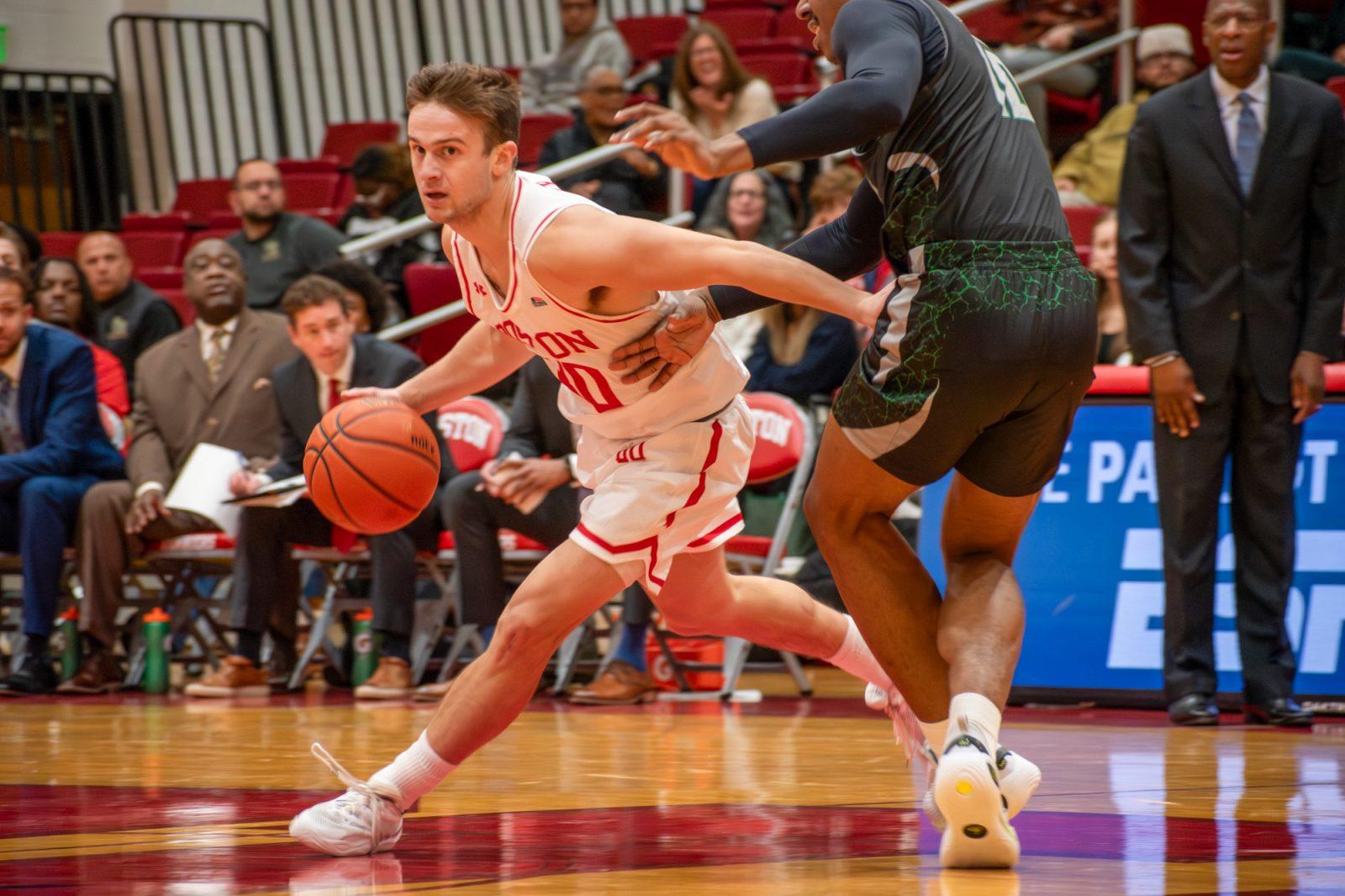This is a tale of two cities. As Charles Dickens wrote: “It was the best of times, it was worst of times . . .” Indeed, there is no better way to describe them.
One city has a college with the initials BU. This school is located in a bigger city, adored for its collegiate culture. This college has a men’s basketball team that has spent the past two years rising to the top of its conference. It has posted an excellent record, played with some of the best teams in the country, and could, just maybe, make their way into the NCAA tournament. It would take a little bit of luck, but anything is possible.
At a bare minimum, they will play in some postseason competition, even if it ends with just another trip to the College Basketball Invitational.
The other city also has a college with the initials BU. That’s all the schools share in similarities, however.
This school is located in a much smaller city, hardly loved. The men’s basketball team at this school has rapidly devolved into a perennial cellar-dweller. It is kind of amazing, though. Just two years ago, they were on top of their conference, champions who played better than expected against Duke in the first round of the NCAA tournament. How far they have fallen since then.
Now, they can barely muster up a home win.
In one of the two cities, the basketball team leads their conference in attendance. They pull in almost 3,500 fans to every game, on average. They play in one of the nicest facilities for miles, drawing in large, exceptionally enthusiastic crowds.
In the other city, the other team plays for a much smaller audience. A contest is considered well-attended if 700 people fill the stands. No one wants to see this team, no matter how much swag the marketing department attempts to give away – hats, scarves, bags, even jerseys can’t create a crowd. It is depressing.
Conventional logic would have the first BU, the school in the better city, with the better record, having the better attendance. The second BU, in the worse city, with the worse record should theoretically have the worse attendance. Why would anyone want to see losers? Winning is what sells tickets.
Wrong.
The first city is Boston. The school, obviously is Boston University. The Terriers, ranked second in America East, lie just behind the returning champions, University of Vermont, in the standings. The Terriers’ schedule has included games against Villanova University and University of Kentucky. Sure, those were losses, but the team took some initiative and challenged themselves. They have considerable potential.
The second city is Vestal, N.Y. The school is Binghamton University. The Bearcats, ranked second-to-last in America East, just two years removed from a conference championship, have fallen on hard times. In the 12 games they have played at home this year, three have been wins. Only one of those came against an out-of-conference opponent.
Yet, despite what these storylines may imply, the team with the better record, Boston University, has the worse attendance. The team with the worse record, Binghamton University, has the better attendance.
It’s shocking, and when you examine the recent history of Bearcat athletics, it becomes that much more incredible.
In 2001, the Bearcats moved from Division II to Division I, capping a 12-year transition led by the then-Athletic Director Joel Thirer. The school, formerly Harpur College, and Triple Cities College before that, became one of four State University of New York schools that moved into the highest level of collegiate athletics.
Once described as the “jewel” of the SUNY system, Binghamton put a heavy emphasis on its new status. Known for its exceptional academics, the administration led a charge to become an exception in athletics as well.
It worked. The Bearcats began to rack up titles in a variety of sports, including a three-year lock on the AE men’s basketball title from 2006-2008.
Last year, it all came crashing down. An investigation revealed that the school was undercutting academics for the athletics. According to The New York Times’ Pete Thamel, members of the basketball team transferred in with credits in Bowling I and Theory of Softball.
In addition, there were major problems off the court and out of the classroom. Multiple players were dismissed from the program after arrests for possession of crack cocaine. One was arrested for assaulting an elderly woman after stealing condoms from a local Wal-Mart, even though the school distributed free condoms on campus.
It seems fair to say the program was, and still is, in ruins. Hope for the success of the athletic program seems like the last thing that should be on the mind of the student body. Restoring a harshly tarnished reputation should be the first.
Yet, despite that fact, the Bearcat faithful continue to show up in droves. They’ve led America East in attendance the last seven seasons, and are on track to repeat again this year. It’s not a small margin, either: 800 over their closest opponent, and 1,500 above the conference average generally attend games at the Binghamton Events Center.
It isn’t like there is much to do in Vestal, a sleepy city located at the convergence of the Susquehanna and Chenango Rivers. Maybe that’s why so many people attend games. But maybe we here in the first city, the one with the better record and the worse attendance, can learn something from Binghamton.
Even as their team, and really their school, has fallen on hard times, they continue to show up. That seems like insanity, but as the ESPN slogan suggests, “It’s not crazy, it’s sports.” Maybe we need to stop thinking it’s crazy to attend a basketball game. Even though there are far more things to do in Boston than in Vestal, why can’t we embrace our teams? And I’m not taking about just basketball and women’s hockey (which I wrote about in a similar fashion a few weeks ago).
Why can’t we celebrate all of our teams? Why can’t we get 3,500 students in an arena for a game? At a school with 16,000 undergrads, is that not possible?




















































































































Craig • Feb 26, 2011 at 12:38 pm
BU can forget about ever getting into the Big East or ACC in the next 30 years, but the Atlantic 10 is a logical next step for this program and athletic department. Getting opponents like Xavier and Temple to come to Agganis will certainly bring more people, even if it doesn’t always sell out. That said, if anyone’s been to hockey games recently, the problem of attendance at BU may very well extend far beyond the basketball program. The reality is that a good majority of BU students don’t care to come out and consistently support their sports teams unless they are doing very well, just a general sense of apathy towards all things BU athletics
Steve • Feb 25, 2011 at 1:54 pm
I think the biggest factor with attendance is location. BC even has poor attendance for playing in the ACC. GW, Temple, Georgetown, I would argue, have attendance woes given their locations in major cities.
BUAlumSMG • Feb 23, 2011 at 7:07 pm
I really like this article, because it is absolutely true. I think the real BU, our Terriers, need to make a conference switch. Who wants to watch a basketball game against University of Hartford? Not me. Binghamton doesn’t have an awesome hockey program, so all they really have is an america east basketball team to watch. The reason hockey is so popular at our school is because we are really good at it and we play other really good teams. We are a national powerhouse and we win national championships. We play BC our most hated rivals four times year. I am sure if we played basketball teams like A-10 opponents like Xavier and Temple or ACC teams like Duke and UNC or Big East teams like Syracuse and Nova more often, I am sure we would all go see those games at Agganis.
That is another point. BU has to switch all games to agganis, regardless of the numbers of fans who go. What college player is going to want to play basketball at a school who plays half of its games at a high school gym?
Back to conference switching, this is a real need for the BU athletics program. Besides the big sports like basketball and hockey, the other sports that we have are really good on a national level. Mens and womens soccer, and basically the rest of women’s sports like lacrosse, field hockey and tennis are all very competitive on a national level. We continually beat other large teams in other conferences, so we can definitely run with the big boys. Look at Providence, its facilities are garbage compared to ours and yet that school is a big east school.
BU basketball fired Wolff to get Chambers to bring us to the next step. In order for that to happen, BU athletics as a whole needs to be taking to the next step.